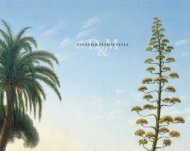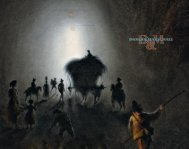Catalogue 2010 - daxer & marschall
Catalogue 2010 - daxer & marschall
Catalogue 2010 - daxer & marschall
You also want an ePaper? Increase the reach of your titles
YUMPU automatically turns print PDFs into web optimized ePapers that Google loves.
CARL GuSTAV CARuS<br />
Moon Rising Behind Pines<br />
Carl Gustav Carus<br />
(Leipzig 1789 - 1869 Dresden)<br />
Moon Rising Behind Pines<br />
Oil on canvas<br />
10.2 x 8 cm<br />
Fig. 1: Carl Gustav Carus, Rising<br />
Moon and Pines, oil on panel,<br />
10.5 x 7 cm<br />
Provenance:<br />
Franz ulrich Apelt collection,<br />
Zittau<br />
34<br />
Carl Gustav Carus’s small-format night painting depicts the motif of a full moon rising behind<br />
pines – images of the moon are one of the key motifs of Romantic artists working in Dresden.<br />
The ‘darkening’ 1 blue (as Carus himself describes it) of the clear night sky has a crystalline intensity. The<br />
‘pale-golden’ orb (again, Carus’s description) of the full moon has a fi ne, reddish coronal ring. The jagged<br />
blackness of the pyramidal crowns of the pines contrasts with the clear blue of the moonlit sky. Specks of<br />
highlighting on the foreground vegetation are designed to simulate the refl ected gleam of the moonlight.<br />
The lowish viewpoint that Carus chose and the heightened contrasts that he achieved through the use of<br />
an almost monochrome palette combine to lend the painting an added dimension independent of both<br />
format and subject.<br />
Carus’s interest in night views and the depiction of moonlight is documented by the large corpus<br />
of moonlight landscapes he produced in the course of his career. 2 However, only on one other occasion<br />
did he handle the subject in miniature dimensions and with concentrated focus. This painting is now in the<br />
collection of the Germanisches Nationalmuseum in Nuremberg (fi g. 1). 3 Carus devotes a whole chapter<br />
in his Briefe über Landschaftsmalerei to what he describes as ‘moonlight pictures’. 4 In his theoretical writings<br />
he reveals himself as a natural scientist and an ‘intelligent landscapist’. 5 Taking the Romantic synthesis of<br />
‘sentiment’ and ‘nature’, he sought to combine this with a determination to objectify the representation<br />
of nature. His representation of a rising moon therefore contained – in addition to aesthetic elaboration<br />
– a precise study of the conditions of light and colour, namely, as he writes, the manner in which [the rising<br />
moon] defi ned itself in the fullness of its colour, yet in deep dusk, against the clear sky, that being, to a degree, still<br />
illuminated by the light of the setting sun, and ... against the darkening blue of the sky, the clear, ... outline of the moon<br />
... emerged. 6<br />
Carus settled in Dresden in 1814. He was a friend of Caspar David Friedrich and a leading member<br />
of his circle. It was Friedrich who established moonlight as a major theme in Romantic painting. Although<br />
Carus began to distance himself from the Friedrich circle in the 1820s, Friedrich’s profound knowledge<br />
of painting techniques and compositional methods had a lasting infl uence on his work. Carus was to draw<br />
on Friedrich’s aesthetic principles and teaching for the rest of his career. On Friedrich’s death he wrote:<br />
Of great value to me was the distinct feeling for pure concentration of light that marked his [Friedrich’s] works. 7<br />
We are grateful to Dirk Gedlich, Dresden, who has confi rmed the attribution to Carus after<br />
examining the painting in the original. He will be including it in the revised edition of the Carus catalogue<br />
raisonné compiled by Marianne Prause.<br />
1. See Carl Gustav Carus, ‘Zehnter Brief’, in Zehn Briefe und Aufsätze über Landschaftsmalerei mit zwölf Beilagen und einem Brief von Goethe als Einleitung,<br />
1815-35, Leipzig and Weimar 1982, p. 118 and p. 116.<br />
2. For a comparison of motifs and technique, see Carl Gustav Carus, exhib. cat., Dresden, Staatliche Kunstsammlungen and Berlin, Staatliche Museen,<br />
Dresden and Berlin 2009, ‚Natur und Idee’, nos. 106-7, 117 and 142.<br />
3. Carl Gustav Carus, Full Moon over Pines, oil on panel, 10.5 x 7 cm, Germanisches Nationalmuseum, Nuremberg, inv. no. GNM 2060 (see fi g.1).<br />
4. [Mondscheinbilder] See Carl Gustav Carus, Zehn Briefe …, op. cit., pp. 115-9.<br />
5. See Kendrik Karge in Carl Gustav Carus, op. cit., ‚Essays’, 233 ff.<br />
6. Carl Gustav Carus, Zehn Briefe…, op. cit., p. 118.<br />
7. Carl Gustav Carus, ‘Lebenserinnerungen und Denkwürdigkeiten’, in Caspar David Friedrich in Briefen und Bekenntnissen, Sigrid Hinz (ed.), Munich<br />
1974, p. 194.






